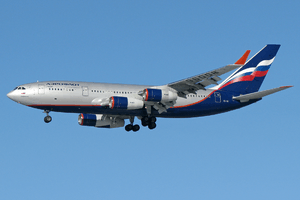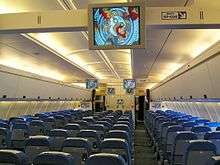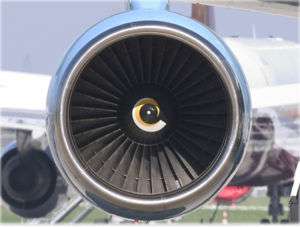Ilyushin Il-96
The Ilyushin Il-96 (Russian: Илью́шин Ил-96) is a Russian quadjet long-haul wide-body airliner designed by Ilyushin in the former Soviet Union and manufactured by the Voronezh Aircraft Production Association in Russia. It is powered by four Aviadvigatel PS-90 two-shaft turbofan engines.
| Il-96 | |
|---|---|
 | |
| An Aeroflot Il-96-300 at Sheremetyevo International Airport in 2011 | |
| Role | Widebody jet airliner |
| Manufacturer | Voronezh Aircraft Production Association |
| Design group | Ilyushin |
| First flight | 28 September 1988 |
| Introduction | 29 December 1992 with Aeroflot |
| Status | In low-rate production; in service |
| Primary user | Cubana |
| Produced | 1992–present[1] |
| Number built | 30[2][3] |
| Unit cost |
US$ 40–50 million |
| Developed from | Ilyushin Il-86 |
Design and development

The Ilyushin Il-96 is a shortened, long-range, and advanced technology development of the Soviet Union's first widebody airliner, the Ilyushin Il-86. It features supercritical wings fitted with winglets, a glass cockpit, and a fly-by-wire control system. It was first flown in 1988 and certified in 1992. The basic Il-96-300 is equipped with modern Russian avionics integrating six multi-function colour LCD displays, inertial and satellite navigation systems, and a Traffic Collision Avoidance System (including mode "S"). It allows the airplane to be operated with two crew members. The avionics correspond to modern requirements on international routes in Europe and North America (RNP-1) and allow navigation and landing under ICAO CAT III/A conditions. The Il-96 is offered in three main variants: the Il-96-300, Il-96M/T and Il-96-400.
The Il-96-300 has a standard passenger capacity of 262 seats in a two-class configuration with 18 seats with a seat pitch of 54 inches (140 cm) and 244 seats with a pitch of 32 inches (81 cm), of which typical seating is 3-3-3 (layout), but low density seating is possible with 2-4-2 (layout). Galleys are positioned on the upper deck, and the lower deck can accommodate 18 LD-3 containers and crew rest areas.

In June 2005, the Volga-Dnepr Group signed a 15-year financial agreement with Ilyushin Finance Corporation (IFC) to take delivery of two new-build Il-96-400T aircraft, to be operated by Volga-Dnepr's subsidiary AirBridge Cargo. The first was due to have been delivered in late 2006.[4]
The Cuban Government newspaper Granma announced on 3 January 2006 the first official flight of the Cubana Il-96-300, from Havana to Buenos Aires, Argentina.[5]
On 11 August 2009 Russian Minister of Industry and Trade Viktor Khristenko announced that manufacturing of the Il-96-300 would cease. In particular, the Il-96-300 had been deemed inferior to counterparts from Boeing and Airbus, and the manufacturer could not arrange commercially viable mass production, making only one aircraft per year.[6] The Il-96-400T cargo version was to remain in production.
On 9 October 2015, it was announced that an updated version of the Il-96 may be produced. This decision was taken due to the current diplomatic situation between Russia and the West, and the dependency of the Russian Aerospace Industry on Airbus and Boeing.[1] In September 2017, the Vice President of Russia's United Aircraft Corporation Aleksandr Tulyakov announced the start of development of the 250–280 seat, wide-body long-haul aircraft in partnership with Chinese builders. The aircraft is to be a development of the Russian-designed IL-96 and will be assembled in China. A new engineering center will be built in Russia to undertake technical and electronics production.
Variants
There are two variants of the Il-96. The Il-96-300 was launched in 1985 with introduction into service in 1993. The Il-96M was launched in 1993 with introduction into service in 2000.
Il-96-300
.jpg)
The Il-96-300 is the initial variant and is fitted with Aviadvigatel (Soloviev) PS-90A turbofans with a thrust rating of 16,000 kgf (157 kN, 35,300 lbf). Development started in the mid-80s while the first prototype flew on 28 September 1988. The first Il-96 entered service with Aeroflot in 1993.
Range with 262 passengers and fuel reserves (for holding 75 minutes at an altitude of 450 m) in a two-class configuration is about 11,000 km (5,940 nmi), allowing flights from Moscow to US west coast cities, a great improvement over the Ilyushin Il-86. A highly customized version of the Il-96-300, called Il-96-300PU is used as the primary aircraft in the Russian presidential aircraft fleet. Four were used by Russian president Vladimir Putin, and by Dmitry Medvedev as VIP planes. The VIP aircraft is operated by Russia State Transport Company.[7] The Cuban leadership use the IL-96-300.
There were plans to produce a variant dubbed Il-96-300V which would include two sets of Airstairs in it.[8]
Il-96M

The Il-96M is a stretched variant of the Il-96-300. It features a 10 m (30 ft) fuselage stretch, is 15 tonnes (33,000 lb) heavier, is fitted with Western-style avionics, and is powered by four Pratt & Whitney PW2337 engines with a thrust rating of 165 kN (37,000 lbf). Range with 312 passengers in a three-class configuration or 92 tonne (203,000 lb) payload is about 10,400 km (5,600 nmi). This turned it into a true—but vastly more capable—Il-86 successor. The Il-96M/T is broadly comparable with the Airbus A330-300 and McDonnell Douglas MD-11CF, but is much cheaper. Development on the M/T variant stalled when the US Export–Import Bank suspended talks on financing the engines and avionics, following pressure from Boeing. The dispute was later settled following an Aeroflot order for ten Boeing 737-400s—placed in April 1997 in a deal worth US$440 million that were granted a tax exemption by the Russian government. Nevertheless, the financing was blocked again when four Boeing 767-300ERs also ordered by Aeroflot were not included in the accorded exemption. The deal was never realised.
Il-96T
This is the freighter version of the Il-96-400. It is powered by four Aviadvigatel PS-90A1 engines.[9]
Il-96-400
_converted_into_passenger_version_from_cargo_variant_for_Ministry_of_Defence_(26461840825).jpg)
The Il-96-400 is similar to the Il-96M, but features Russian avionics and engines. It is powered by four Aviadvigatel PS-90A1 turbofans and can carry up to 436 passengers. Typical two-class configuration will have 386 passengers. Range with 315 passengers in a three-class configuration is about 10,000 km.[10] A special version, dubbed Il-96-400VT, was reported on Friday 19 March 2010 by the Wall Street Journal to bid on the US$40 billion Air Force Tanker Program contract.[11] In February 2013, Cubana signed a deal for the order of three 350-seater Ilyushin Il-96-400s.[12]
One modified Il-96-400, nicknamed the Doomsday plane, is used as an airborne command post by the Russian Air Force.[13]
Il-96-400M
In February 2017, it was announced that Russia's United Aircraft Corporation had signed a contract with its subsidiary Ilyushin Aviation Complex for the development of a new version of Ilyushin Il-96-400 wide-body passenger airliner. Il-96-400M is the passenger version of the Il-96-400T cargo aircraft. Its fuselage is 9.65 m longer than the existing Il-96-300 passenger variant. The planned seating capacity is 390 passengers.[14][15] In 2017, the Russian Government injected ₽3.6 billion ($57.4 million) into the Ilyushin Il-96-400M.[16] By January 2020, the first test-flight airframe was in final assembly and the wing and fuselage were joined, to be finished at the end of 2020 before a first flight in 2021.[17]
Il-96-400TZ
In January 2015, a new tanker variant of the Il-96, designated the Il-96-400TZ, was proposed, with an initial order for two aircraft placed by the Russian Ministry of Defense.[18] The new tanker would have been able to transfer more than 65 tons (IL-78M 40 tons) of fuel at a distance of up to 3500 km (Il-78M 3000 km). Universal aviation refueling systems ORM-1, proven on existing combat aircraft tankers Il-78/78М, would have been installed on the aircraft.[19] According to Alexei Krivoruchko, Russian Deputy Minister of Defense, factory trials of the Il-96-400TZ are expected to be completed in May, 2020.[20]
Twin engine
To reduce fuel consumption and maintenance costs, Ilyushin is studying a twin-engined development, powered by over 340 kN (76,000 lbf) Aviadvigatel PD-35s developed by 2025 from the PD-14, or foreign powerplants.[21]
Operators
Current operators
As of December 2016, current operators of the Ilyushin Il-96 are:[22]
| Operator | Aircraft Type | In service | On order | Stored |
|---|---|---|---|---|
| Il-96-300 | 4 | 3 | 1 | |
| Il-96-300 | 1 | — | — | |
| Il-96-300 | 10 | — | — | |
| Il-96-400T | — | — | 1 | |
| Il-96-400TZ | — | 2 | — | |
| Total | 15 | 5 | 2 |
Accidents and incidents
In the entire history of operation with the IL-96, there have been no accidents causing the deaths of passengers or crew.
- In 2005, Russia indefinitely grounded Ilyushin 96-300 passenger aircraft after transport inspectors pointed out malfunctions in the jets’ braking systems. The decision came just weeks after a technical glitch in an Ilyushin 96-300 forced Russian President Vladimir Putin to fly in a back-up plane during a visit to Finland.[25]
- On 3 June 2014, RA-96010 of Aeroflot, which had been retired from service, was damaged beyond economical repair in a fire while parked in storage at Sheremetyevo International Airport, Moscow.[26]
Specifications
| Variant | Il-96-300 | Il-96M | Il-96T | Il-96-400 |
|---|---|---|---|---|
| Cockpit crew | 3 | 2 | 2/3 | |
| Seats (3/2/1-class) | 237/263/300 | 307/340/420 | 315/386/436 | |
| Cargo capacity | 25 t | 776 m³ | 196 m³ | |
| LD3 capacity | 16 | 32 | ||
| Length | 55.3 m (181 ft 7 in) | 64.7 m (212 ft 3 in) | 63.9 m (209 ft 9 in) | |
| Wing | 60.11 m (197 ft 3 in) span, 350 m² (3767.9 ft²), 30° sweep | |||
| Fuselage | 6.08 m (19.94 ft) diameter, 5.70 m (18.70 ft) cabin width[28] | |||
| Height | 15.7 m (57 ft 7 in) | |||
| OEW | 120.4 t (265,198 lb) | 132.4 t (291,630 lb) | 116.4 t (256,387 lb) | 122.3 t (269,383 lb) |
| MTOW | 250 t (551,000 lb) | 270 t (595,000 lb) | 270 t (594,713 lb) | 265 t (583,700 lb) |
| Max. payload | 40 t (88,105 lb) | 58 t (127,753 lb) | 92 t (202,643 lb) | 58 t (127,753 lb) |
| Fuel capacity | 152,620 l (40,322 US gal) | |||
| Engines (×4) | Aviadvigatel PS-90A[lower-alpha 1] | PW2037 | PW2337 or PS-90A1 | PS-90A1[lower-alpha 2] |
| Thrust (×4) | 156.9 kN (35,242 lbf) | 170.1 kN (38,250 lbf) | 166.8 kN (37,500 lbf) | 170.7 kN (38,326 lbf) |
| Cruise | 0.78-0.84 Mach / 850-870 km/h / 459-469 kn TAS; 13,100 m (43,000 ft) Ceiling | |||
| Range (max. payload) | 11,500 km (6,209 nmi) | 12,800 km (6,907 nmi) | 5,000 km (2,699 nmi) | 10,000 km (5,400 nmi) |
| Takeoff run (MTOW) | 2,340 m (7,677 ft) | 3,000 m (9,843 ft) | 2,700 m (8,858 ft) | 2,700 m (8,858 ft) |
| Landing run | 860 m (2,821 ft) | 1,800 m (5,906 ft) | 1,650 m (5,511 ft) | 1,650 m (5,511 ft) |
- All the PS-90A turbofan can be upgraded to the new PS-90A2 version, with the latest generation FADEC of western design and many other improvements. The maintenance costs are reduced by 40%. The fuel consumption (SFC) of this version is equivalent to current Western turbofans. PS-90A2 variant meets the ETOPS-180 rules, ICAO-4 and AP-33 (equivalent to FAR-33/JAR-33). The maximum thrust is 16,000 kg or 18,000 kg.[29]
- Ilyushin has not ruled out the possibility to install other engines (PW, RR, or CFM), depending on the number of requests from customers.
Avionics

The airplane has the following systems installed, providing compliance with ICAO recommendations and Eurocontrol requirements:
- Integrated communication and navigation control panel and flight management system
- Upgraded EFIS with LCD indicators
- Inertial navigation system
- Ground proximity warning system
- TCAS
- SELCAL
- Weather radar
- Aircraft Communications Addressing and Reporting System with satellite communication.
- Flight Data Recorder and Cockpit Voice Recorder
See also
Related development
Aircraft of comparable role, configuration and era
- Airbus A330
- Airbus A340
- Airbus A350
- Boeing 767-400
- Boeing 777-200
- Boeing 787-10
- McDonnell Douglas MD-11
Related lists
References
- "В России воссоздадут конкурента Boeing и Airbus". Новости Mail.Ru. Archived from the original on 2015-12-24. Retrieved 2015-11-09.
- "✈ russianplanes.net ✈ наша авиация". Archived from the original on 2015-12-11.
- Стрюк, Игорь. "22.07.2016: Новый Ил-96 передан специальному летному отряду "Россия"". Retrieved 14 August 2016.
- "Volga–Dnepr Group signs up for two new Il-96-400T aircraft". VOLGA-DNEPR GROUP. 27 March 2005. Archived from the original on October 16, 2007. Retrieved 29 March 2014.
- Gómez Lluciá, Julio (January 3, 2006). "Realiza su primer vuelo oficial IL 96-300 de" (in Spanish). Granma. Archived from the original on March 4, 2008.
- Kolobkov, Sergei (August 11, 2009). "The short-lived Il-96-300" (in Russian). RBC Daily. Archived from the original on August 14, 2009. Retrieved 2009-08-01.
- "Ilyushin Il-96 Production List". Archived from the original on 1 April 2015. Retrieved 26 March 2015.
- Александр, Артемьев. "ШИРОКОФЮЗЕЛЯЖНЫЙ ДАЛЬНЕМАГИСТРАЛЬНЫЙ ПАССАЖИРСКИЙ САМОЛЕТ ИЛ-96-300—Крылья сверхдержавы". www.e-reading.club.
- "Ил-96-400Т—ПАО "Ил"". www.ilyushin.org.
- "Il-96-400". Ilyushin. Archived from the original on September 19, 2008.
- John Pike. "Il-96-400VT Aerial Tanker". Retrieved 26 December 2014.
- "Cubana buys Antonov An-158 and Il-96-400s". 2013-02-22. Archived from the original on 4 October 2013. Retrieved 26 December 2014.
- "Russian Next-Generation 'Doomsday Plane' Finally Ready for Action". sputniknews.com. 28 July 2016.
- Insider, Russian Aviation (14 February 2017). "Improved Ilyushin Il-96 airliner to fly in 2019—Russian aviation news". rusaviainsider.com. Retrieved 26 January 2019.
- "VASO to Build a Passenger Il-96-400M Prototype by 2019". 15 August 2016.
- Vladimir Karnozov (July 9, 2018). "Kremlin Boosts Effort toward 'Indigenization' of SSJ100". AIN online.
- David Kaminski-Morrow (10 January 2020). "Wings mated to flight-test Il-96-400M". Flightglobal.
- "MAKS: Russia extends Il-96 production by several years". Flightglobal. 27 August 2015. Retrieved 31 August 2015.
- "Минобороны России закупит новые самолеты-топливозаправщики". function.mil.ru. Retrieved 3 July 2015.
- "Заводские испытания топливозаправщика Ил-96-400ТЗ завершат в мае" (in Russian). RIA Novosti. 3 February 2020. Retrieved 3 February 2020.
- David Kaminski-Morrow (9 Feb 2018). "Ilyushin studies twin-engined version of Il-96". Flightglobal.
- "✈ russianplanes.net ✈ наша авиация". Archived from the original on 2015-12-11. Retrieved 2015-12-16.
- "Ilyushin Il-96 Production List". planespotters.net. Retrieved 2019-05-10.
- Ильюшин Ил-96. russianplanes.net (in Russian). Retrieved 2019-05-10.
- "Russia: Ilyushin Planes Grounded After Putin Jet Suffers Glitch". RadioFreeEurope/RadioLiberty. Retrieved 2017-12-20.
- Hradecky, Simon. "Accident: Aeroflot IL96 at Moscow on Jun 3rd 2014, caught fire while parked". The Aviation Herald. Retrieved 3 June 2014.
- "Il-96-300". ILYUSHIN a UAC company. Retrieved 29 March 2014.
- "Flight – Airline Industry news, aviation jobs & airline recruitment". Flightglobal.com. Archived from the original on 2012-03-13. Retrieved 2009-12-20.
- avid.ru/eng/advanced-developments
External links
| Wikimedia Commons has media related to Ilyushin Il-96. |